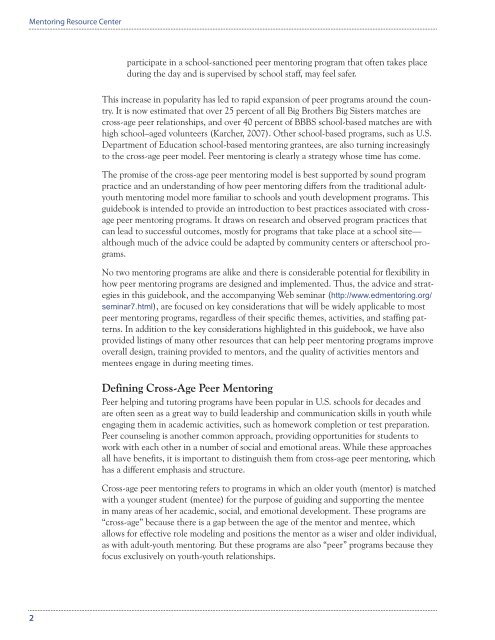1zRGGrv
1zRGGrv
1zRGGrv
Create successful ePaper yourself
Turn your PDF publications into a flip-book with our unique Google optimized e-Paper software.
Mentoring Resource Center<br />
participate in a school-sanctioned peer mentoring program that often takes place<br />
during the day and is supervised by school staff, may feel safer.<br />
This increase in popularity has led to rapid expansion of peer programs around the country.<br />
It is now estimated that over 25 percent of all Big Brothers Big Sisters matches are<br />
cross-age peer relationships, and over 40 percent of BBBS school-based matches are with<br />
high school–aged volunteers (Karcher, 2007). Other school-based programs, such as U.S.<br />
Department of Education school-based mentoring grantees, are also turning increasingly<br />
to the cross-age peer model. Peer mentoring is clearly a strategy whose time has come.<br />
The promise of the cross-age peer mentoring model is best supported by sound program<br />
practice and an understanding of how peer mentoring differs from the traditional adultyouth<br />
mentoring model more familiar to schools and youth development programs. This<br />
guidebook is intended to provide an introduction to best practices associated with crossage<br />
peer mentoring programs. It draws on research and observed program practices that<br />
can lead to successful outcomes, mostly for programs that take place at a school site—<br />
although much of the advice could be adapted by community centers or afterschool programs.<br />
No two mentoring programs are alike and there is considerable potential for flexibility in<br />
how peer mentoring programs are designed and implemented. Thus, the advice and strategies<br />
in this guidebook, and the accompanying Web seminar (http://www.edmentoring.org/<br />
seminar7.html), are focused on key considerations that will be widely applicable to most<br />
peer mentoring programs, regardless of their specific themes, activities, and staffing patterns.<br />
In addition to the key considerations highlighted in this guidebook, we have also<br />
provided listings of many other resources that can help peer mentoring programs improve<br />
overall design, training provided to mentors, and the quality of activities mentors and<br />
mentees engage in during meeting times.<br />
Defining Cross-Age Peer Mentoring<br />
Peer helping and tutoring programs have been popular in U.S. schools for decades and<br />
are often seen as a great way to build leadership and communication skills in youth while<br />
engaging them in academic activities, such as homework completion or test preparation.<br />
Peer counseling is another common approach, providing opportunities for students to<br />
work with each other in a number of social and emotional areas. While these approaches<br />
all have benefits, it is important to distinguish them from cross-age peer mentoring, which<br />
has a different emphasis and structure.<br />
Cross-age peer mentoring refers to programs in which an older youth (mentor) is matched<br />
with a younger student (mentee) for the purpose of guiding and supporting the mentee<br />
in many areas of her academic, social, and emotional development. These programs are<br />
“cross-age” because there is a gap between the age of the mentor and mentee, which<br />
allows for effective role modeling and positions the mentor as a wiser and older individual,<br />
as with adult-youth mentoring. But these programs are also “peer” programs because they<br />
focus exclusively on youth-youth relationships.<br />
2


